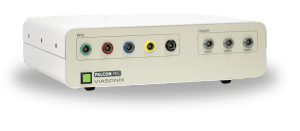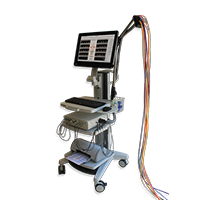What is MVO/SVC?
The MVO/SVC test (Maximal Venous Outflow / Segmental Venous Capacitance) is a specific functional physiological lower limb venous test that helps diagnose obstructions to the venous circulation in the legs.

This test helps healthcare professionals assess the venous blood flow and capacitance ability of the venous circulation, which can indicate the presence of conditions like edema or other venous outflow obstructions.
By measuring the MVO/SVC ratio, clinicians can identify potential circulation problems in the legs.
How to Perform MVO/SVC Test
Performing an MVO/SVC test requires proper technique and adherence to established protocols.
Performing an MVO/SVC test requires proper technique and adherence to established protocols. Here is a step-by-step guide on how to perform an MVO/SVC test:
Step 1: Positioning the Patient
- Ask the patient to lie down in a supine position on an examination table.
- Elevate the patient’s legs slightly to aid in venous blood pooling.
Step 2: Applying the Cuffs
- Wrap one pressure cuff around the patient’s thigh, ensuring a snug fit.
- Place a second pressure cuff around the patient’s calf, also ensuring a proper fit.
Step 3: Inflation of Cuffs
- Inflate the thigh cuff to venous occlusion pressure, typically around 60 mmHg. This occludes the venous circulation in the lower leg.
- Inflate the calf cuff to a lower pressure, around 20 mmHg. This cuff serves as a sensor to detect limb circumference changes.
Step 4: Test Progress
- As the thigh cuff is inflated, venous blood will start to accumulate in the lower leg, and the sensor cuff will show an increase in pressure.
- The pressure in the sensor cuff will steadily increase until it reaches a steady-state baseline (“plateau”).
- Once the plateau is reached, rapidly deflate the occluding thigh cuff.
- The pressure in the sensor cuff will also rapidly return to the initial control levels.
Step 5: Calculating MVO and SVC
- The MVO and SVC are based on the pressure values as read by “sensor” pressure cuff (placed around the calf). The units of MVO and SVC are mmHg.
- Find the “Baseline” pressure, which is the pressure read by the sensor cuff as soon as the Thigh cuff starts inflating.
- Find the “Plateua” pressure, which is the stabilized pressure read by the sensor cuff a moment before the rapid deflation of the thigh cuff starts.
- Find the “Drop” pressure – the pressure read by the sensor cuff at a predefined number of seconds following the rapid deflation of the thigh cuff (usually 2 or 3 seconds).
- The Segmental Venous Capacitance (SVC) = “Plateua” pressure – “Baseline” pressure.
- The Maximal Venous Outflow (MVO) = “Plateua” pressure – “Drop” pressure.
- The MVO/SVC ratio (in percent) is simply the MVO divided SVC.
Step 6: Analyzing the Results
- If there is an obstruction to venous outflow, such as severe edema, the venous emptying from the plateau level will take longer. As a result, MVO will decrease, and the MVO/SVC ratio will also decrease compared to normal values.
This step-by-step guide for performing an MVO/SVC test is for informational purposes only. Healthcare professionals should rely on their expertise, clinical judgment, and institutional protocols for accurate administration and interpretation. Additional clinical information, patient history, physical examination, and other diagnostic tests may be necessary for comprehensive evaluation.
Using the Falcon for MVO/SVC Test
The Falcon vascular system offers a range of advantages when conducting the Maximal Venous Outflow (MVO) and Segmental Venous Capacitance (SVC) test, enhancing the accuracy, efficiency, and diagnostic potential of this crucial procedure. Here are some key benefits of using the Falcon for the MVO/SVC test:
- Dedicated Protocol: The Falcon comes with a dedicated MVO/SVC test protocol that guides examiners through each step of the examination process.
- Unilateral and Bilateral Measurements: The Falcon supports both unilateral and simultaneous bilateral measurements, providing to reduce test time.
- Customizable Parameters: Examiners can configure the sensing cuff pressure and venous occlusion pressures according to their preferences and institutional criteria.
- Zoom-In Waveform: The Falcon offers automatic zoom-in waveform display for both time scale and pressure scale to focus the most interesting phase – the rapid deflation process.
- Automatic Calculation: The Falcon automatically calculates and displays the values of MVO, SVC, and the MVO/SVC ratio for each leg.
- Adjustable Cursors: The program places automatic cursors at the baseline and plateau levels during the inflation and deflation phases of the thigh cuff. These cursors can be manually adjusted by the examiner for precise measurement, ensuring reliable results.
- Alert Configuration: The Falcon allows examiners to configure alerts that can help identify circulation problems.
- Variability in MVO Calculation Time: The Falcon enables the examiner to adjust the MVO calculation time between 1 second and up to 5 seconds (following Thigh cuff rapid deflation), providing flexibility in assessing the dynamics of venous blood flow during the test.
- Comprehensive Reporting: The Falcon generates comprehensive reports that display the complete waveforms, including graphs and ratios.
Expected Results of MVO/SVC Test
It is expected that when obstruction to venous flow in the legs exists, for example, edema, then the MVO/SVC ratio decreases. It is estimated that an MVO/SVC ratio below 50% indicates a problem such as:
Edema: Severe edema can lead to decreased venous outflow due to increased resistance in the veins. A reduced MVO/SVC ratio could signal the presence of edema and associated venous insufficiency.
Venous Outflow Obstructions: Conditions like deep vein thrombosis (DVT) or venous stenosis can restrict blood flow through the veins. A lower MVO/SVC ratio could point to the presence of such obstructions.
Chronic Venous Insufficiency: Reduced MVO/SVC ratios might be indicative of chronic venous insufficiency, where the venous valves fail to function properly, leading to blood pooling in the lower extremities.
Example of a Bilateral Maximum Venous Outflow (MVO)/Segmental Venous Capacitance (SVC) specialty test measured with Viasonix Falcon/PRO. Both legs were measured simultaneously. The top graphs show the complete measurements and the graphs below present a zoom-in on the deflation part (blue rectangle). The resulted MVO/SVC ratio is displayed on the schematic picture.

Selected Literature
Venous capacitance and venous return in young adults with typical vasovagal syncope: a cross-sectional study, Udi Nussinovitch et al., J Investig Med. 2021 Sep 27
Venous volume displacement plethysmography: Its diagnostic value in deep venous thrombosis as determined by receiver operator characteristic curves, Kevin J. McBride et al., Cardiovascular Diseases, Volume 8 Number 4 December 1981, pp 499-508
Disclaimer of Information & Content
The content of Viasonix Ltd. website is for information only, not advice or guarantee of outcome. Information is gathered and shared from reputable sources; however, Viasonix Ltd. Management is not responsible for errors or omissions in reporting or explanation. No individuals, including those under our active care, should use the information, resources or tools contained within this self-diagnosis or self-treat any health-related condition. Viasonix Ltd. Management gives no assurance or warranty regarding the accuracy, timeliness or applicability or the content.








